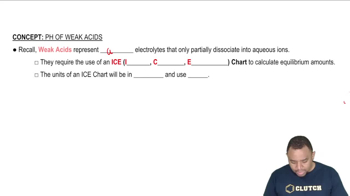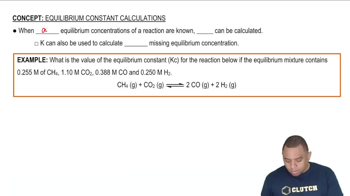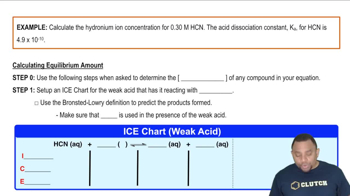Here are the essential concepts you must grasp in order to answer the question correctly.
Weak Acids and Acid Dissociation Constant (Ka)
Weak acids are substances that partially dissociate in solution to produce hydrogen ions (H3O+). The strength of a weak acid is quantified by its acid dissociation constant (Ka), which measures the extent of dissociation. A higher Ka value indicates a stronger weak acid, while a lower Ka suggests a weaker acid. In this problem, both acetic acid and benzoic acid are weak acids with given Ka values, which are essential for calculating their contributions to the pH.
Recommended video:
Simultaneous Equilibrium Calculations
When multiple weak acids are present in a solution, their dissociation reactions can affect each other, leading to a situation where no single principal reaction dominates. To find the pH, one must set up and solve the equilibrium expressions for each acid simultaneously. This involves defining variables for the concentrations of dissociated species and applying the equilibrium constants (Ka) to create a system of equations that can be solved together.
Recommended video:
Equilibrium Constant Calculation
pH Calculation from Hydronium Ion Concentration
The pH of a solution is a measure of its acidity, defined as the negative logarithm of the hydronium ion concentration: pH = -log[H3O+]. In this scenario, the total concentration of hydronium ions is the sum of the contributions from both weak acids, represented as [H3O+] = x + y, where x and y are the amounts of acetic and benzoic acids that dissociate, respectively. Calculating the pH requires determining this total concentration from the equilibrium expressions.
Recommended video:
Hydronium Ion Concentration Example




